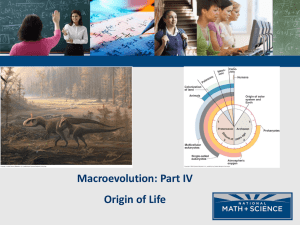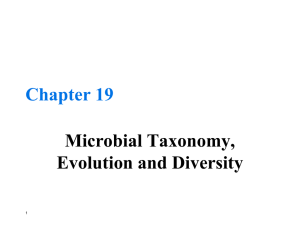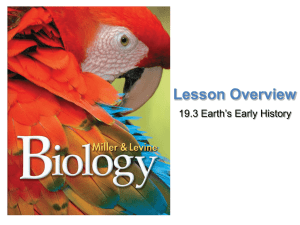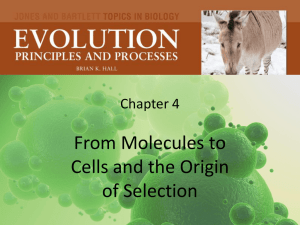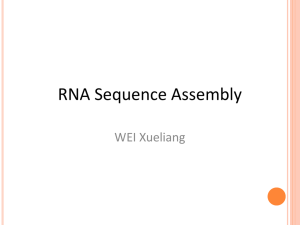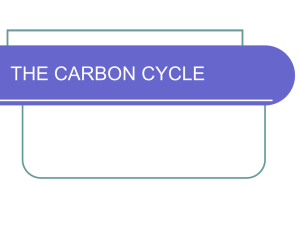Macroevolution: Part IV Origin of Life
advertisement
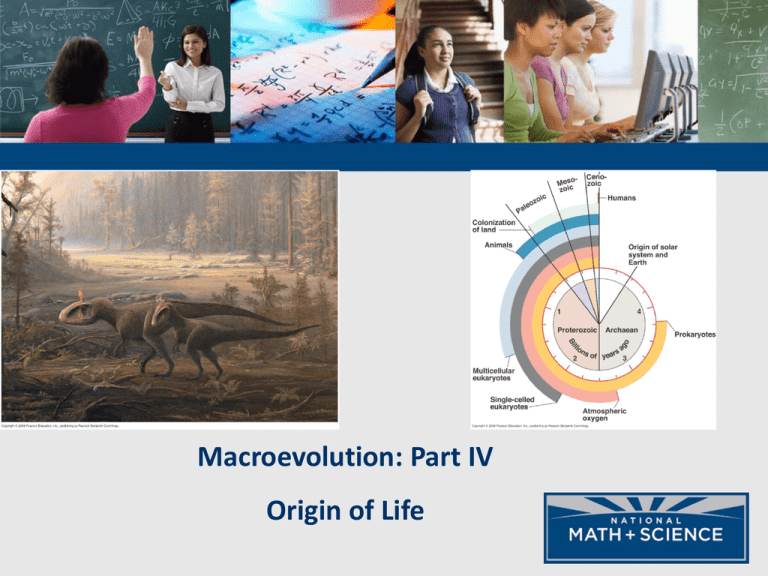
Macroevolution: Part IV Origin of Life Creation Of The Universe • Based on studies of the modern universe, it is estimated that the universe began in a single instant 13-15 billion years ago. • In that instant all existing energy appeared and exploded outward from a single point. • This is known as the Big Bang. Creation Of The Universe • After its initial expansion from a singularity, the Universe cooled sufficiently to allow energy to be converted into various subatomic particles, including protons, neutrons, and electrons. • While protons and neutrons combined to form the first atomic nuclei only a few minutes after the Big Bang, it would take thousands of years for electrons to combine with them and create electrically neutral atoms. • The first element produced was hydrogen, along with traces of helium and lithium. Creation Of The Universe • Giant clouds of these primordial elements would coalesce through gravity to form stars and galaxies, and the heavier elements would be synthesized either within stars or during supernovae. Creation of the Solar System and the Earth • Our sun formed about 5 billion years ago. • In our universe there were clouds of dust and asteroids (large space rocks). Collisions between the asteroids formed larger and larger asteroids which increased their gravitational pull finally forming planets. Formation of Earth is estimated at 4.6 billion years ago. • Even after Earth formed, it was constantly bombarded by meteorites. • An early atmosphere formed that contained water vapor, carbon dioxide, gaseous hydrogen and nitrogen, with little or no oxygen gas. • The oldest rocks found containing iron showed no oxidation (rusting). • Oxidation is found in more recent rock formations. Radioisotopes Can Date Rocks and Fossils • Radioactive isotopes decay in a predictable pattern over a long period of time. • A half-life is the amount of time it takes for exactly one half of a certain amount of radioactive material to undergo radioactive decay and form a new substance. • Carbon-14 or 14C decays into 14N. • The half-life of 14C is 5,700 years. All living organisms have the same ratio of 14C to 12C, but the amount of 14C begins to decay once the organism dies and is no longer a part of the food chain. • Determining the amount of 14C in a fossil indicates its age. • Potassium-40 has a half-life of 1.3 billion years and uranium-238 has a half-life of 4.5 billion years. Possible Steps in the Origin of Life • Shown are the steps necessary to create life as we know it Early Atmosphere is Anaerobic • Oxygen is a very corrosive gas. It oxidizes or breaks down many molecules. • If oxygen was present in the early atmosphere, life as we know it would not exist. • When the earth formed, it was extremely hot with many volcanic eruptions. • Steam and ice from meteorites provided Earth with water. Experimental Design: The origin of life on this planet • The Miller-Urey experiment demonstrated the abiotic synthesis of organic compounds. • Water (H2O), methane (CH4), ammonia (NH3), and hydrogen (H2) were all sealed inside a sterile array of glass tubes and flasks connected in a loop, with one flask half-full of liquid water and another flask containing a pair of electrodes. 9 Experimental Design: The origin of life on this planet • The liquid water was heated to induce evaporation, sparks were fired between the electrodes to simulate lightning through the atmosphere and water vapor, and then the atmosphere was cooled again so that the water could condense and trickle back into the first flask in a continuous cycle. 10 Experimental Design: The origin of life on this planet • Within a day, the mixture had turned pink in color, and at the end of two weeks of continuous operation, Miller and Urey observed that as much as 10–15% of the carbon within the system was now in the form of organic compounds. 11 Experimental Design: The origin of life on this planet • Two percent of the carbon had formed amino acids that are used to make proteins in living cells, with glycine as the most abundant. Nucleic acids were not formed within the reaction. But the common 20 amino acids were formed, in various concentrations. 12 Synthesis of Small Organic Monomers • Günter Wächtershäuser proposed the Iron-Sulfur World Theory and suggested that life might have originated at hydrothermal vents (underwater geysers). • Iron sulfide can donate electrons to dissolved carbon dioxide to form larger organic compounds. • This may have been the beginnings of metabolic reactions. Synthesis of Small Organic Monomers • Mineral rich water is heated by geothermal energy. • Simulated hydrothermal vents using carbon monoxide (CO) and potassium cyanide (KCN) produced amino acids. • This is an attractive hypothesis because of the abundance of CH4 (methane) and NH3 (ammonia) present in hydrothermal vent regions, a condition that was not provided by the Earth's primitive atmosphere. Synthesis of Small Organic Monomers • Meteorites that fall to Earth today will often contain amino acids, carbohydrates and nucleotide bases. • This suggests that organic molecules could have formed in interstellar clouds and then been transported to Earth on meteorites. • Billions of years ago, there were enormous amounts of meteorites falling to Earth. Polymer Synthesis • It has been shown that a solution of amino acids dropped onto a hot clay surface could result in the formation of polypeptide chains. (There is still much debate about the appearance of polymers.) • Lipids will also form organized droplets with bilayer much like that of a plasma membrane. • Liposomes can reproduce as they incorporate more lipids or pinch off smaller droplets. Some liposomes can perform a simple metabolic reaction. Protocell Synthesis Some liposomes can reproduce and perform simple metabolic reactions as shown in the figure below. Protocells in a RNA World Cells consist of a lipid membrane, a genome of DNA that is transcribed into RNA and ribosomes that translate the RNA into proteins. • The lipid membrane rather easily assembles into liposomes. • Some metabolic reactions could have started in the presence of iron-sulfide at the thermal vents with products that eventually moved into the liposomes. Protocells in a RNA World • The first genetic material is believed to be RNA. • RNA can self-replicate and RNA can have exhibit catalytic properties like enzymes. • A ribozyme is an RNA molecule that can be catalytic, but self-cleaving ribozymes are consumed by their reactions. • The RNA world hypothesis describes an early Earth with self-replicating and catalytic RNA but no DNA or proteins. So, When Did Life Begin? • The Earth formed approximately 4.6 billion years ago, but the environment was too hostile for life until about 3.9 billion years ago. • The earliest fossil evidence for life dates to 3.5 billion years ago. • Taken together, this evidence provides a plausible range of dates when the origin of life could have occurred. 20 Prokaryotes •As genomes increased in size, it became more advantageous for DNA rather than RNA to become the primary molecule of the genome. •Why? •DNA is physically more stable than RNA and a less likely to mutate during replication. Prokaryotes Characteristics of the first cells: 1. Prokaryotes 2. Anaerobic as there was no oxygen in the atmosphere 3. First came the common ancestor, then 3.5 billion years ago the prokaryotes evolved into two groups: Bacteria and Archaea Photosynthesis • The next big biochemical pathway that evolved was photosynthesis. When first evolved, photosynthesis did not produce oxygen. (3.5 billion years ago) • About 3 billion years ago modern day photosynthesis took place in cells resembling cyanobacteria and evolved to produce oxygen, thus converting the atmosphere from a reducing atmosphere into an oxidizing atmosphere. • This conversion caused major changes on Earth. Consequences of Oxygen Production Production of oxygen began 2.7 billion years ago. Consequences? 1. Life can no longer arise from nonliving materials. 2. Organisms that can tolerate oxygen are at an advantage. Obligate anaerobes either became extinct or found anaerobic (without oxygen) environments. 3. Some oxygen formed ozone, O3 which filtered out UV radiation like the oceans do. Consequences of Oxygen • Organisms that tolerated oxygen survived. • The next major biochemical pathway that evolved was aerobic respiration. • Aerobic respiration is more efficient at making ATP than anaerobic respiration. Advantages of Compartmentalizing The phylogenetic tree shown indicates that Eukarya are more closely related to Archaea than Bacteria. At one time, these two domains had a common ancestor before splitting into two groups. The evolution of the eukaryotic cell involved two processes: Compartmentalizing & Endosymbiosis 26 Advantage of Compartmentalizing • Excess membrane folded inward to make the endoplasmic reticulum, nuclear envelope, Golgi apparatus, and lysosomes. • The advantage of having compartments (or organelles) is to localize chemical or metabolic pathways with a common function. 27 Endosymbiosis As eukaryotes were evolving, there were two separate events that resulted in additional organelles for eukaryotes. • A symbiotic relationship developed between an ancestral aerobic heterotrophic bacterial prokaryote (not an Archaea) and a eukaryotic cell. • For whatever reason, this energyproducing aerobic prokaryote took up residence inside the engulfing eukaryotic cell and was not destroyed. Endosymbiosis • The energy-producing aerobic prokaryote eventually became the mitochondrion. • Eventually some of the genes from the mitochondrion were relocated to the nucleus but other genes remained. (mitochondrial DNA) • Humans inherit their mother’s mitochondrial DNA since only the nucleus of a sperm fertilizes a human egg. Same Song, Second Verse • A symbiotic relationship developed between an ancestral autotrophic bacterial prokaryote (not an Archaea) and a eukaryotic cell. • The autotrophic prokaryote eventually became the chloroplast. • Eventually some of the genes from the chloroplast were relocated to the nucleus but other genes remained in the chloroplast. • Occurred after the endosymbiotic event of the mitochondrion as all photosynthetic eukaryotic cells have mitochondria! Evidence for Endosymbiosis • Both mitochondria and chloroplasts have their own ribosomes but the ribosomes more closely resemble bacterial ribosomes. • Both mitochondria and chloroplasts carry out protein synthesis like a bacterial cell. • Both have their own DNA but it more similar to bacterial DNA than nuclear DNA. Evidence for Endosymbiosis Since eukaryotic cells have genes from a common ancestral cell that gave rise to both Archaea and Eukarya, and have genes from the Bacterial domain due to endosymbiosis, scientists often refer to The Ring of Life as opposed to a phylogenetic tree as shown in the previous slides. Evolution of Singled Celled Eukaryotes Earliest evidence of eukaryotic cells is 2.7 billion years old Eukarya and Sexual Reproduction • The next evolutionary milestone is the advent of sexual reproduction in eukaryotic cells. Red algae is pictured on the right and it is the oldest species known to reproduce sexually. • Sexual reproduction ensures genetic variability and exchange of genetic material. As a result, evolution occurs more rapidly. • Most eukaryotes are protists (singled-celled eukaryotes) and not multicellular organisms. Eukarya and Multicellular Organisms • Following the emergence of sexual reproduction, the next milestone is the evolution of multicellular eukaryotes. The oldest multicellular species known is a small algae appearing 1.2 billion years ago. • By 900 mya representatives of all the major lineages, including algae, fungi, & animals had evolved in the seas. Multicellularity gave way to cell specialization and specialized body parts. • Larger and more diverse multicellular organisms do not appear until 565 million years ago due to the fact that landmasses as well as the seas were largely covered with ice often referred to as the “Snowball Earth”. Cambrian Explosion • Many phyla of living animals first appear in the fossil record during the Cambrian Explosion of 535-525 million years ago. • Appearance of animals with exoskeletons, spines, and body armor. • Some animals became carnivores with large claws and other features for capturing prey. Colonization of Land • Larger more complex forms of life move onto land about 500 million years ago. • Successful plant adaptations such as a vascular system for transporting materials, supportive tissue, waxy cuticles to prevent dehydration, and the ability to reproduce on land occurred 420 million years ago. • By 50 million years ago there was a great diversification of plants. Colonization of Land • Fungi moved onto land about the same time as plants. They structurally simpler than animals or plants. • Needed animal adaptations include: prevention of dehydration, support, and reproductive success on land. Colonization of Land • Arthropods were the most successful. • The tetrapods inhabited the terrestrial environment 365 million years ago. • The common ancestor for man and chimpanzee existed 6-7 million years ago. • Homo sapiens arrived 195,000 years ago. Changes on Earth Influence Evolution • The earth’s crust consist of several solid plates as shown. The plates (40 km thick) are sitting on a layer of molten magma. These plates can move by sliding under one another, or gliding past one another. Continental Drift • Over the course of time the continents have been together as one large land mass (Pangaea) and at other times they have been apart as they are now. • These movements cause changes in climate, ocean currents, the formation of glaciers and other geological phenomenon. • These changes occur slowly, but can result in mass extinctions. Changes on Earth Influence Evolution The Permian Extinction or the Great Dying • A single volcano can cool global temperatures. • 251 million years ago in Serbia there was a collision of continents which caused a multitude of volcanic eruptions. • At this time all the continents were one (Pangea). • The eruption is thought to have produced a tremendous amount of ash, blocking the sunlight, thus affecting glacial formations and the oceans. • The Permian extinction or Great Dying wiped out 96% of all marine species and 70% of the terrestrial species. Cretaceous Mass Extinction • This mass extinction occurred 65 million years ago. Fifty percent of all marine species went extinct and many families of terrestrial animals also went extinct. • This extinction was caused by a meteorite colliding with Earth. It caused great tsunamis and a massive plume of debris that rose into the atmosphere and spread around Earth. • It heated the atmosphere several hundred degrees and ignited massive fires. It also blocked the sun which greatly affected plant Great Oxygen Catastrophe • Since the beginning of photosynthesis, 2.4 billion years ago, oxygen has been produced as a byproduct of metabolic processes. For the first billion or so years after the onset of photosynthesis, oxygen levels remained low because the oxygen reacted with minerals like iron that could be oxidized. Great Oxygen Catastrophe Increases in oxygen levels led to a mass extinction of obligate anaerobes that could not tolerate oxygen. Maximum oxygen levels were reached 250 million years ago. Great Oxygen Catastrophe • The large plants lived in low, swamp land. As the plants died they were buried in the swamp. • The buried plants did not decompose and eventually became deposits of coal. • The swamp lands dried up and oxygen production decreased to levels even lower than today. Tempo of Evolution Tempo of Evolution Created by: Carol Leibl Science Content Director National Math and Science
